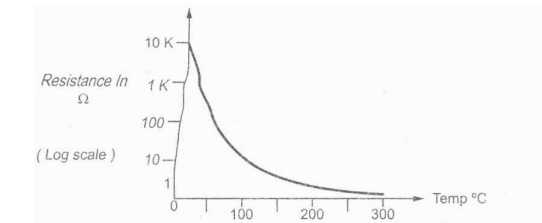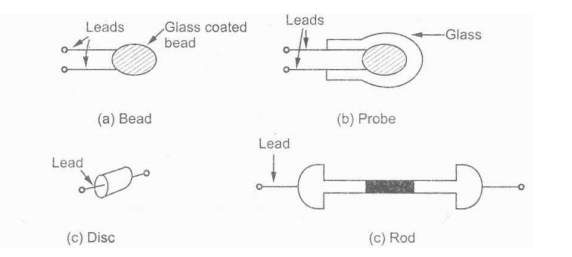Thermistors: Construction, Advantages, Limitations
Thermistors
Ø Thermistor is a contraction of a term ‘ thermal-resistors’ .
Ø Thermistors are semiconductor device which behave as thermal resistors having negative temperature coefficient [ i.e. their resistance decreases as temperature increases.
Ø The below Fig. shows this characteristic.

Construction of Thermistor
Ø Thermistors are composed of a sintered mixture of metallic oxides, manganese, nickel, cobalt, copper, iron, and uranium.
Ø Their resistances at temperature may range from 100 to 100k .
Ø Thermistors are available in variety of shapes and sizes as shown in the Fig.

Ø Smallest in size are the beads with a diameter of 0.15 mm to 1.25 mm.
Ø Beads may be sealed in the tips of solid glass rods to form probes.
Ø Disks and washers are made by pressing thermistor material under high pressure into flat cylindrical shapes.
Ø Washers can be placed in series or in parallel to increase power dissipation rating.
Ø Thermistors are well suited for precision temperature measurement, temperature control, and temperature compensation, because of their very large change in resistance with temperature.
Ø They are widely used for measurements in the temperature range -100 C to
+100 C
Advantages of Thermistor
1. Small size and low cost.
2. Comparatively large change in resistance for a given change in temperature
3. Fast response over a narrow temperature range.
Limitations of Thermistor
1. The resistance versus temperature characteristic is highly non-linear.
2. Not suitable over a wide temperature range.
3. Because of high resistance of thermistor, shielded cables have to be used to minimize interference.
Applications of Thermistor
1. The thermistors relatively large resistance change per degree change in temperature [known as sensitivity ] makes it useful as temperature transducer.
2. The high sensitivity, together with the relatively high thermistor resistance that may be selected [e.g. 100k .], makes the thermistor ideal for remote measurement or control. Thermistor control systems are inherently sensitive, stable, and fast acting, and they require relatively simple circuitry.
3. Because thermistors have a negative temperature coefficient of resistance, thermistors are widely used to compensate for the effects of temperature on circuit performance. 4. Measurement of conductivity.

